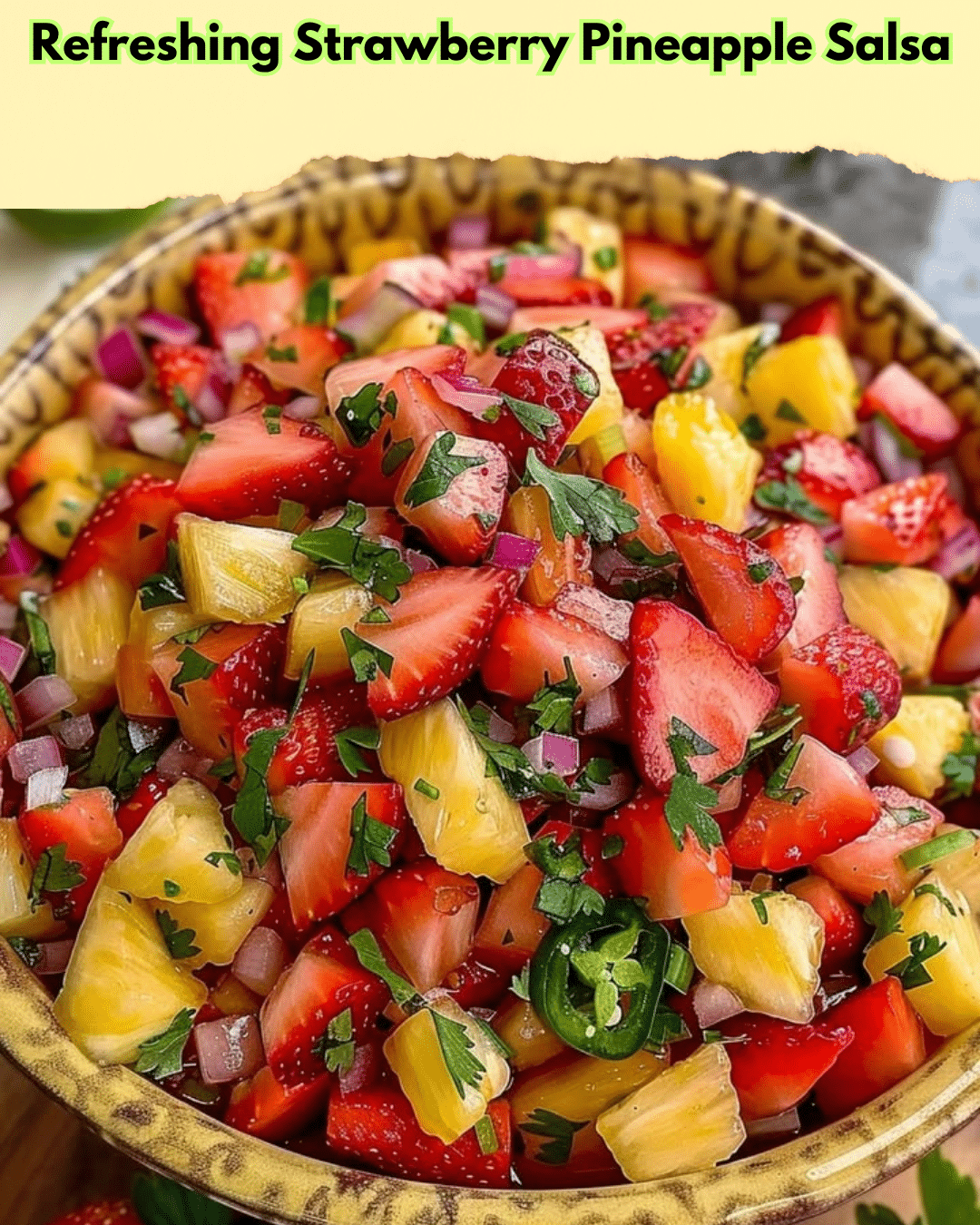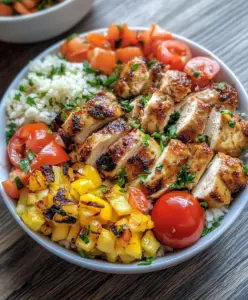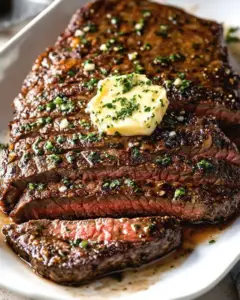Refreshing Strawberry Pineapple Salsa: A Tropical Delight for Your Taste Buds
Indulge in the tantalizing flavors and vibrant colors of our refreshing Strawberry Pineapple Salsa. This zingy concoction marries the natural sweetness of sun-ripened strawberries with the tangy, tropical allure of fresh pineapple. Infused with a hint of lime and a whisper of cilantro, this salsa becomes the perfect accompaniment or snack. Ideal for summertime gatherings, this fruit salsa is as delightful as a beach getaway in a bowl, bringing an explosion of fresh flavors right to your table.
Quick Recipe Highlights
- Flavor Profile: A fusion of sweet strawberries and succulent pineapple accentuated by lime’s tang and cilantro’s boldness creates a refreshing medley of tropical flavors.
- Texture: The salsa boasts a delightful crunch from chopped pineapple, contrasted with the soft, juicy consistency of strawberries and a slight chew from red onions.
- Aroma: The zesty citrus notes harmoniously blend with the fresh, sweet scent of ripe fruits, enticing your senses from the first whiff.
- Visual Appeal: A tasteful mix of vivacious reds, yellows, and greens makes this salsa a feast for the eyes, resembling a summer bouquet.
- Skill Level Needed: Simple chopping skills and the ability to mix ingredients are all you need.
- Special Equipment: A sharp knife and a cutting board are essential for preparing perfect fruit chunks.
Recipe Overview
- Difficulty Level: This salsa is rated as easy due to its straightforward chopping and mixing process that requires minimal culinary skill, making it ideal for novice cooks.
- Category: This recipe falls under the category of appetizers or snacks, perfect for the start of a meal or a mid-afternoon refresher.
- Cuisine: While deeply rooted in tropical influences, this salsa draws inspiration from Latin American traditions, known for their vibrant and lively dishes.
- Cost: The ingredients are reasonably priced, with fresh produce being the central component, making this an economical option for any budget.
- Season: Best enjoyed in the warmer months when strawberries and pineapples are at their peak, offering optimal sweetness and flavor.
- Occasion: Ideal for summer cookouts, casual get-togethers, or any occasion to showcase a colorful and refreshing side.
Why You’ll Love This Recipe
The blend of fresh strawberries and pineapple creates a perfectly balanced sweet and tangy taste, enhanced by lime and cilantro’s zesty notes. Texture plays a critical role in this salsa, providing a juicy bite with each spoonful, making it both refreshing and satisfying. The preparation couldn’t be more straightforward, allowing you to whip up this dish in minutes, perfect for sudden cravings or unexpected guests.
In terms of nutrition, this salsa is a powerhouse of vitamins and antioxidants, offering a healthy snacking alternative without compromising on flavor. Its social and entertaining value is unmatched, as you can easily serve this alongside grilled meats or as a snack with tortilla chips, making it a favorite at any gathering. Economically, the cost-effectiveness of using seasonal fruits, paired with the ease of access to the ingredients, ensures that this recipe can be a staple throughout the year.
Historical Background and Cultural Significance
Fruit-based salsas like the Strawberry Pineapple Salsa have slowly evolved, drawing influence from traditional Mexican salsas that emphasize fresh, vibrant ingredients. Historically, this approach to salsa highlights the resourcefulness of communities across Latin America, integrating local fruits with traditional components. Over time, these salsas have gained international popularity, celebrated for their refreshing qualities and adaptability in various culinary contexts.
Different regions have embraced their own versions, experimenting with a myriad of fruit combinations, spices, and herbs, underlining salsa’s versatility. Such adaptations blend culinary traditions with modern palates, enriching cultural exchanges through food. The Strawberry Pineapple Salsa exemplifies a modern take on this cultural phenomenon, inviting a global audience to partake in its rich heritage.
Ingredient Deep Dive
Strawberries are a staple in many dessert and breakfast options due to their inherent sweetness and vibrant color. Culturally, they are often celebrated in festivals worldwide. Nutritionally, strawberries provide essential vitamins, particularly Vitamin C, acting as powerful antioxidants. When selecting, choose firm, bright red strawberries without any soft spots. To store, keep them refrigerated and rinse only when ready to use to prevent moisture damage. If strawberries aren’t available, raspberries can serve as a creative substitute.
Pineapple, with its tropical essence, adds a unique tangy profile to any dish. Rich in Vitamin C and manganese, it offers numerous health benefits, including digestive aid. When picking a pineapple, look for a slight give when pressed and a sweet, fragrant aroma at the base. Store pineapples at room temperature until cut, then refrigerate. Mango or papaya can substitute for pineapple if desired, offering a similar exotic flair.
Common Mistakes to Avoid
- Using underripe fruit drastically affects flavor, making the salsa less sweet and satisfying. Ensure fruits are ripe for optimal taste balance.
- Over-mixing can lead to mushy salsa, diminishing texture. Gently fold the ingredients to maintain distinct fruit pieces.
- Ignoring the importance of lime juice as it prevents the fruits from browning while providing necessary acidity and zest.
- Inadequately seasoning the salsa will make it bland. Salt is crucial in enhancing the natural sweetness and balancing the flavors.
- Not allowing the salsa to rest shortchanges the melding of flavors; a brief resting period can significantly enhance the taste profile.
- Forgetting to taste and adjust seasoning can result in unsatisfactory flavor balance, always taste before serving.
- Chopping fruit inconsistently compromises both texture and presentation. Aim for uniformly small, even pieces.
- Using too much cilantro can overpower delicate flavors; add gradually and taste frequently.
- Serving the salsa too cold can mute its flavors. Allow it to sit briefly at room temperature for maximum taste impact.
Essential Techniques
Proper Chopping: Consistency in chopping ensures even distribution of flavors and texture within the salsa. Mastering this technique requires practice, careful knife control, and an understanding of how ingredient sizes impact taste.
Flavor Balancing: Balancing sweet, sour, and fresh components is crucial for a well-rounded salsa. Approach adjustments like an artist, gradually building layers of flavor with lime and salt, tasting regularly to achieve harmony.
Visual Cues for Success: Bright, vibrant colors and an enticing aroma are signs of a well-executed salsa. If the colors appear dull or the fruits seem soft, reframing your approach might be necessary.
Pro Tips for Perfect Strawberry Pineapple Salsa
Choose ripe but firm fruits to ensure a sweet yet structured salsa, preventing it from becoming overly soft.
The resting period allows flavors to meld, providing a richer taste, so don’t skip this step.
Stir in lime juice just before serving for heightened zest and preservation.
For a spicy twist, consider adding a finely chopped chili pepper to the mix.
For best results, serve the salsa chilled but not too cold, highlighting its vibrant flavor notes.
Experiment with additional herbs like mint for a fresh variation without straying too far from the tropical theme.
Adding a pinch of sugar can accentuate the fruits’ natural sweetness if needed.
Variations and Adaptations
Regional variations could see the introduction of mango for an even more tropical taste, whereas seasonal adaptations might use peaches when strawberries aren’t in season. For those following specific diets, omit added sugar for a diabetic-friendly version. Including diced avocado and cucumber can create a more diverse texture experience. Reimagining the presentation could involve serving the salsa inside a hollowed pineapple for an attractive display at parties.
Serving and Presentation Guide
For artistic plating, consider a layered presentation in a glass or meticulously spooned into endive leaves for individual bites. Elevate garnish by using edible flowers or a sprinkle of chia seeds. Classic accompaniments include tortilla chips or serve as a topping on grilled chicken or fish dishes. Ensure to present the salsa at room temperature for the best flavor profile. Portion wise, pair distinguishable amounts to highlight the tastes’ integrity on each plate.
Wine and Beverage Pairing
Pairing this salsa with a light Moscato complements the innate sweetness of the fruit without overshadowing it. Non-alcoholic options like sparkling water with a hint of lime provide refreshing acidity. If serving during brunch, a fruit-infused herbal tea pairs beautifully. Temperature should be moderately chilled, ensuring the taste profile remains vibrant. Offer tasty, subtle beverages that enhance rather than compete with the salsa’s fresh elements.
Storage and Shelf Life
The fridge is ideal for storing leftover salsa in an airtight container for up to three days, retaining freshness and flavor. Be mindful of cross-contamination and use clean utensils during handling. Signs of spoilage include an off odor or noticeable discoloration. For extended storage, consider freezing only the fruits without cilantro and lime, adding fresh herbs and juice upon defrosting when ready to serve.
Make Ahead Strategies
Optimizing this recipe ahead of time enhances the scope of convenience in entertaining settings. Prepare all dry components a day prior and keep them chilled. Just before serving, mix in lime and cilantro to maintain optimal freshness and flavor. Assess whether the texture remains intact to ensure quality. Immediate refrigeration after assembly secures its vibrant freshness, readying the salsa for serving right out of storage with minimal fuss.
Scaling Instructions
When doubling or tripling this recipe, maintain proportionate lime juice and cilantro to ensure balanced flavors. Utilize larger mixing bowls and factor in increased preparation time for chopping. Consider storage solutions ahead to prevent overcrowding in the refrigerator. Scaling down retains ease, quickness, and freshness of the dish without compromising flavor. Portion into small containers to preserve taste over successive servings.
Nutritional Deep Dive
The macro breakdown of this salsa is predominantly carbohydrates, primarily from the fruit, with negligible amounts of protein and fat. Micronutrient highlights include high vitamin C levels and antioxidants, promoting a healthful intake with each bite. Its low-caloric content makes it an attractive option for weight-conscious individuals seeking a satisfying snack. Each portion is naturally low in sodium, aligning with dietary guidelines for reduced salt consumption while delivering a fresh, sweet-tangy palate.
Dietary Adaptations
For gluten-free adaptation, ensure that any accompaniments like chips or crackers are labeled gluten-free. Eliminating any added sugars caters to a ketogenic diet’s requirements. Vegan diets can easily enjoy this salsa as it contains no animal products. For low-carb diets, serve atop leafy greens or in an avocado bowl, enhancing nutrition without extra carbohydrates. Additionally, paleo adherents will find a complementary fit with the adherence to whole, unprocessed ingredients outlined in the paleo philosophy.
Troubleshooting Guide
If your salsa results in an overly sour taste, add a small amount of sugar incrementally until the desired flavor is achieved. A lack of flavor depth may require additional lime juice or cilantro finely chopped to enhance. For overly watery salsa, ensure to drain excess pineapple juice before mixing. Balancing temperature issues can simply mean allowing the dish to settle at room kiss for better integration. Opt for equipment that finely chops ingredients without over-processing them into mush.
Recipe Success Stories
Community feedback consistently praises the refreshing quality of this salsa, often adapting it with varied fruits or spicy elements based on availability and preference. A reader shared their unique twist using mango and jalapeños, a success at family gatherings. Many have reported using fruit diced now as decorative toppings in photogenic culinary presentations. Suggestions include pairing this salsa with coconut shrimp for visual and taste appeal alongside shared photos using professional tips, fostering culinary exploration.
Frequently Asked Questions
Can I use frozen strawberries for the salsa?
Frozen strawberries can be used if fresh ones aren’t available. Thaw them first and pat dry to minimize extra water content.
How long does the salsa stay fresh?
Stored in the refrigerator in an airtight container, the salsa remains fresh for up to three days.
Is it important to rest the salsa before serving?
A brief resting period of about 30 minutes enhances the melding of flavors, amplifying taste.
What can I substitute for cilantro?
Fresh mint or parsley can replace cilantro, each imparting a different but complementary flavor.
How do I keep the salsa from becoming watery?
Ensure fruits are properly drained, and serve with a slotted spoon to control excess liquid.
Can I add other fruits to the salsa?
Yes, seasonal fruits like mango or avocado can be added for variety and a richer flavor profile.
Are there beverages that pair well with this salsa?
A fruit-forward Moscato or sparkling water with lime pairs excellently, accentuating the salsa’s notes.
What’s the best way to chop cilantro?
Use a sharp knife, folding the leaves tightly for uniform, fine chopping, maximizing flavor integration.
Is this salsa appropriate for a keto diet?
Without added sugar, it’s a satisfying keto-friendly choice when adhering to portion considerations.
Can this salsa be prepared in advance for a party?
Prepare in advance without lime and cilantro, adding them just before serving for ultimate freshness.
Additional Resources
Explore our related recipes for more culinary inspirations, ranging from Mango Avocado Salsa to Spicy Sweet Corn Salsa, each offering unique flavor combinations. Master your knife skills and tropical fruit usage with our culinary technique guides. Discover insights into ingredient sourcing, ensuring you pick the best produce available. Equip your kitchen with our product recommendations, optimizing the preparation and serving of this zesty salsa. For more inspiration, check out our seasonal guides tailored for fresh produce usage, ensuring flavorful results with every culinary endeavor.
Print
Refreshing Strawberry Pineapple Salsa
Description
A vibrant and fruity salsa perfect for summer gatherings or as a topping for grilled dishes.
Ingredients
For the Crust:
- 1 cup diced strawberries
- 1 cup diced pineapple
- 1/4 cup chopped red onion
- 1 tablespoon chopped fresh cilantro
- 1 tablespoon lime juice
- Salt to taste
Instructions
1. Prepare the Crust:
- In a large bowl, combine diced strawberries and pineapple.
- Add chopped red onion and cilantro to the mixture.
- Drizzle with lime juice and sprinkle with salt, then gently toss to combine.
- Chill in the refrigerator for at least 15 minutes before serving.
Notes
You can customize the seasonings to taste.




